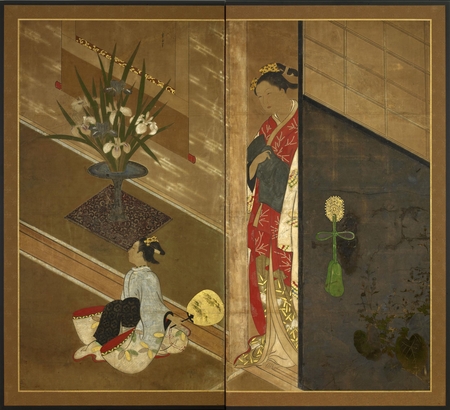Product Description
6305(13C) A two-fold paper screen painted in ink and colour on a buff ground with a bijin (beauty) entering a room.
Signed: Toyonao hitsu. (Painted by Toyonao)
Seal: Toyonao no in. (The seal of Toyonao)
Japan 19th century Edo period
Dimensions: H. 65” x W. 71” (164.5cm x 180cm)
The scene depicts an Oiran (high ranking courtesan) entering a room through a shoji door, her kamuro (trainee courtesan) awaits her and one can assume they are about to meet an important client. Both the Oiran and her attendant have matching tortoise-shell combs, (it was a common practice for them to complement each other in their dress) the kamuro also holds a gilded uchiwa (fan) decorated with a landscape. The left hand panel depicts a tokonoma (formal display area) with a kakemono (hanging scroll) and a bronze flower vessel containing an ikebana arrangement of kakitsubata (iris) a classic reference to the month of May.
Whilst we have been unable to find a specific reference to Toyonao, there is a long line of ukiyo-e artists who use the character Toyo as the first character of their name. This particular painting bears strong similarities to the work of Nishikawa Sukenobu (1671-1750) considered to be the most accomplished and influential Ukiyo-e painter in Kyoto during the first half of the 18th century.
For a kakemono treated in a similar manner by Sukenobu in the collection of Sumisho, Tokyo see: Images du Monde Flotant, Peintures et Estampes Japonaises XVIIe – XVIIIe siècles, Galeries Nationals du Grand Palais, Paris, pp. 220/221 no. 86 and another by the same artist in the collection of the British Museum see: Ukiyo-e Paintings p. 83 pl.32.
Screens painted in the Ukiyo-e style are rare. For a six-fold example from the collection of the British Museum, London, see: Ukiyo-e Paintings in the British Museum p.106 pl.56








